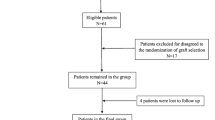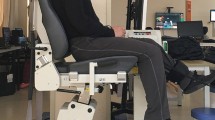Abstract
Several studies have shown that patients with anterior cruciate ligament (ACL) reconstruction have an improved proprioceptive function compared to subjects with ACL-deficient knees. The measurement of functional scores and proprioception potentially provides clinicians with more information on the status of the ACL-reconstructed knees. To evaluate proprioception in patients following ACL reconstruction with a bone–tendon–bone (BTB) graft, we used the angle reproduction in the sitting, lying and standing positions and the one-leg hop test. Forty-five patients between 19 and 52 years of age were investigated in a 36-month period after the operation. For functional performance measurement, the International Knee Documentation Committee (IKDC) score was used. Very good and good results were seen in 95% of cases. All patients returned to the same activity level as seen before ACL repair. There was a significant difference in the active angle reproduction test between the ACL-reconstructed knees and normal knees in the active sitting position. Tests with passive angle adjustment in the sitting, lying and active standing positions did not show any differences in proprioceptive skills. Good to very good results in the one-leg hop test we found in 95% of patients. After ACL reconstruction, deficiencies in the active angle reproduction test were very small but, nevertheless, were still observed. Overall, the functional and proprioceptive outcomes demonstrate results to recommend the procedure.
Résumé
Plusieurs études ont montré que des patients ayant bénéficié d’une reconstruction du ligament croisé antérieur ont été améliorés sur le plan de la fonction proprioceptive surtout si on compare les sujets à des sujets non traités gardant un déficit au niveau du ligament croisé antérieur. La mesure des différents scores, fonction et proprioception, donne un certain nombre d’informations sur ces genoux qui ont été opérés. Nous avons évalué la proprioception de patients opérés par greffes du ligament croisé antérieur par un greffon de type BTB et évalué cette proprioception en position assise, debout, en appui monopodal et après tests de sauts.45 patients entre 19 et 52 ans ont été analysés sur une période de 36 mois après l’intervention chirurgicale. Le score IKDC a également été mesuré. Les résultats ont été considérés comme très bons dans 95% des cas. Les patients ont repris une activité au même niveau que celle qu’ils avaient avant la réparation. Il n’y a pas de différences significatives entre les genoux reconstruits et le genou normal, notamment en ce qui concerne les tests en positions assises. Un très bon résultat des tests de sauts est retrouvé chez 95% des patients. On peut considérer après reconstruction du ligament croisé antérieur, que la récupération fonctionnelle et proprioceptive est excellente et confirme la nécessité de reconstruire les ligaments après rupture.




Similar content being viewed by others
References
Adachi N, Ochi M, Uchio Y, Iwasa J, Ryoke K, Kuriwaka M (2002) Mechanoreceptors in the anterior cruciate ligament contribute to the joint position sense. Acta Orthop Scand 73:330–334
Al-Othman AA (2004) Clinical measurement of proprioceptive function after anterior cruciate ligament reconstruction. Saudi Med J 25:195–197
Bonfim TR, Jansen Paccola CA, Barela JA (2003) Proprioceptive and behavior impairments in individuals with anterior cruciate ligament reconstructed knees. Arch Phys Med Rehabil 84:1217–1223
Borsa PA, Lephart SM, Irrgang JJ, Safran MR, Fu FH (1997) The effects of joint position and direction of joint motion on proprioceptive sensibility in anterior cruciate ligament-deficient athletes. Am J Sports Med 25:336–340
Carter ND, Jenkinson TR, Wilson D, Jones DW, Torode AS (1997) Joint position sense and rehabilitation in the anterior cruciate ligament deficient knee. Br J Sports Med 31:209–212
Delay BS, Smolinski RJ, Wind WM, Bowman DS (2001) Current practices and opinions in ACL reconstruction and rehabilitation: results of a survey of the American Orthopaedic Society for Sports Medicine. Am J Knee Surg 14:85–91
Fischer-Rasmussen T, Jensen PE (2000) Proprioceptive sensitivity and performance in anterior cruciate ligament-deficient knee joints. Scand J Med Sci Sports 10:85–89
Fremerey RW, Lobenhoffer P, Zeichen J, Skutek M, Bosch U, Tscherne H (2000) Proprioception after rehabilitation and reconstruction in knees with deficiency of the anterior cruciate ligament: a prospective, longitudinal study. J Bone Joint Surg Br 82:801–806
Friden T, Roberts D, Ageberg E, Walden M, Zatterstrom R (2001) Review of knee proprioception and the relation to extremity function after an anterior cruciate ligament rupture. J Orthop Sports Phys Ther 31:567–576
Friemert B, V Lubken F, Schmidt R, Jouini C, Gerngross H (2006) The influence of a controlled active motion splint on proprioception after anterior cruciate ligament plasty. A prospective randomized study (in German). Unfallchirurg 109:22–29
Good L, Roos H, Gottlieb DJ, Renstrom PA, Beynnon BD (1999) Joint position sense is not changed after acute disruption of the anterior cruciate ligament. Acta Orthop Scand 70:194–198
Hopper DM, Creagh MJ, Formby PA, Goh SC, Boyle JJ, Strauss GR (2003) Functional measurement of knee joint position sense after anterior cruciate ligament reconstruction. Arch Phys Med Rehabil 84:868–872
Howell SM, Taylor MA (1993) Failure of reconstruction of the anterior cruciate ligament due to impingement by the intercondylar roof. J Bone Joint Surg Am 75(7):1044–1055
Iwasa J, Ochi M, Adachi N, Tobita M, Katsube K, Uchio Y (2000) Proprioceptive improvement in knees with anterior cruciate ligament reconstruction. Clin Orthop Relat Res 381:168–176
Jensen TO, Fischer-Rasmussen T, Kjaer M, Magnusson SP (2002) Proprioception in poor- and well-functioning anterior cruciate ligament deficient patients. J Rehabil Med 34:141–149
Jerosch J, Prymka M (1996) Proprioceptive capacity of the knee joint area in patients after rupture of the anterior cruciate ligament (in German). Unfallchirurg 99:861–868
Katayama M, Higuchi H, Kimura M, Kobayashi A, Hatayama K, Terauchi M, Takagishi K (2004) Proprioception and performance after anterior cruciate ligament rupture. Int Orthop 28:278–281
MacDonald PB, Hedden D, Pacin O, Sutherland K (1996) Proprioception in anterior cruciate ligament-deficient and reconstructed knees. Am J Sports Med 24:774–778
Pap G, Machner A, Nebelung W, Awiszus F (1999) Detailed analysis of proprioception in normal and ACL-deficient knees. J Bone Joint Surg Br 81:764–768
Peters GG, Wirth CJ, Kohn D (1997) Vergleich von Scores und Bewertungsschemata bei Kniebandinstabilitäten (in German). Z Orthop Ihre Grenzgeb 135:63–69
Raunest J, Sager M, Burgener E (1996) Proprioceptive mechanisms in the cruciate ligaments: an electromyographic study on reflex activity in the thigh muscles. J Trauma 41:488–493
Reider B, Arcand MA, Diehl LH, Mroczek K, Abulencia A, Stroud CC, Palm M, Gilbertson J, Staszak P (2003) Proprioception of the knee before and after anterior cruciate ligament reconstruction. Arthroscopy 19:2–12
Risberg MA, Beynnon BD, Peura GD, Uh BS (1999) Proprioception after anterior cruciate ligament reconstruction with and without bracing. Knee Surg Sports Traumatol Arthrosc 7:303–309
Roberts D, Andersson G, Friden T (2004) Knee joint proprioception in ACL-deficient knees is related to cartilage injury, laxity and age: a retrospective study of 54 patients. Acta Orthop Scand 75:78–83
Wilke C, Froböse I (2003) Quantifizierung propriozeptiver Leistungen von Kniegelenken (Quantification of proprioceptive skills of the knee joint). Dtsch Z Sportmed 54:49–54
Author information
Authors and Affiliations
Corresponding author
Rights and permissions
About this article
Cite this article
Anders, J.O., Venbrocks, R.A. & Weinberg, M. Proprioceptive skills and functional outcome after anterior cruciate ligament reconstruction with a bone–tendon–bone graft. International Orthopaedics (SICO 32, 627–633 (2008). https://doi.org/10.1007/s00264-007-0381-2
Received:
Accepted:
Published:
Issue Date:
DOI: https://doi.org/10.1007/s00264-007-0381-2




